18 Jun ASC 606 – Healthcare Industry

Table of Contents
-
-
-
- Background Information.
- Transition Approach.
- Policy Details.
- Step 1 – Identify the contract with a customer.
- Step 2 – Identify the performance obligations in the contract.
- Step 3 – Determine the transaction price.
- Step 4 – Allocate the transaction price.
- Step 5 – Recognize revenue as performance obligations are satisfied.
- Presentation of statement of financial position.
- Case Study.
-
-
Revenue is an important point of concern to the users of Financial Statements in assessing an entityís Financial Performance and Position.
Accounting Standard Codification (ASC) 606 ñ Revenue from Contract with Customers is an Industry-wide revenue recognition guidance which has been formulated by the Financial Accounting Standard Board (FASB). This was a joint task by Financial Accounting Standard Board (FASB) and International Accounting Standard Board (IASB) to clarify the principles for Revenue Recognition and to develop common revenue standard for U.S. GAAP and IFRS.
ASC 606 is applicable across all the industries and aid in recognizing revenue from all the types of transactions, except those transactions which are covered by more specific guidelines (for example ñ Insurance Contract or Leasing Contract).
ASC 606 was introduced to improve the way revenue recognition was been carried out per ASC 605. This document is to introduce the readers the impact of ASC 606 on the Healthcare Industry.
This article covers:
The timing, amount and pattern of Revenue Recognition for a Healthcare Industry.
BACKGROUND INFORMATION
Company Background
ABC Hospital is a multispecialty hospital consisting of more than 500 beds. The hospital has acquired an image of quality treatment and is said to have the best team of cardiologist in the country. It has tie-ups with various insurance providers and thus provides cashless treatment facility along with the normal facility of paying across the counter.† The hospital also receives grants and contributions from the Government and General Public.
Offerings
The hospital mainly offers the following products/services:
- Short- term hospitalization
- Emergency room services
- General and Specialty surgical services
- X-ray and Radiology services
- Laboratory services
- Blood services
TRANSITION APPROACH

The ABC Hospital selected to apply the ëmodified retrospective methodí with the following practical expedient as provided by the new standard and as applicable:
For contracts that were modified before the beginning of the earliest reporting period presented, the Hospital will not restate the contract for those contract modifications. Instead, the Hospital will reflect the aggregate effect of all modifications that occur before the beginning of the earliest period presented.
POLICY DETAILS
Revenue Recognition Framework
The ABC Hospital recognizes revenue to depict the transfer of promised goods and services to customers in an amount that reflects the consideration to which the Company expects to be entitled in exchange for those goods and services.
5 step model for revenue recognition

Depending on the circumstances, the guidance may be applied on a contract-by-contract basis, or the practical expedient described in ASC 606-10-10-4 of using the portfolio approach may be followed. The portfolio approach allows an entity to apply the guidance to a portfolio of contracts with similar characteristics so long as the result would not differ materially from the result of applying the guidance to individual contracts. The Hospital will decide whether to apply the portfolio approach on a case-by-case basis as appropriate.
The Hospitalís approach to applying each of these steps is discussed in detail throughout the remainder of this section.
IDENTIFY THE CONTRACT(S) WITH A CUSTOMER
Step 1 of the revenue recognition model requires the Company to identify the contract(s) with a customer. This section discusses the steps to determine whether a contract exists and specific considerations that may impact that determination. Each contract will need to go through this evaluation.
Per ASC 606-10-25-1, the five criteria for identifying a contract are elaborated as follows:
a. The parties have approved the contract and are committed to perform.
- Sales directly to end customers
- A signed purchase agreement. Or
- A standard purchase order of the form normally issued by the customer, supporting the customerís commitment to receive and pay for products and/or services specified in the quotation and/or contract, which is approved by the Companyís legal and finance department.
- The Company does not consider the contract approved until both parties have executed the documents. Such execution is deemed to have occurred as of the last signature date.
- The approved contracts described above must be executed before the end of the accounting period in which revenue is to be recognized and be provided to the order entry location by midnight Pacific time. Faxed documents will not be considered received unless they are legible and complete.
- Contracts, in general, are reviewed and executed by the Legal Team. All non-standard contracts should be reviewed by the Revenue Team and approved by the VP of Finance prior to being executed.
b. Each partyís rights are identifiable:
Rights should all be documented in writing within the terms and conditions of the approved contracts described above.
c. Payment terms are identifiable:
The Company is obligated to perform the services ordered by the customer and agreed to by the Company.† The customer is also obligated to pay the Company the prices for agreed goods and services. The Companyís bills are payable immediately upon receipt of the bill without any deduction, unless other payment terms and conditions are expressly agreed.
d. The contract has commercial substance:
When the risk, timing, or amount of the Companyís future cash flow is expected to change as a result of the contract. Generally, an executed contract is evidence of commercial substance.
e. The collection is probable based on the customerís ability and intent to pay:
The amount deemed collectible may be less than the contractual price: The collectability assessment only applies to consideration associated with goods or services to be transferred during the non-cancellable term of the contract. The Companyís contracts with its customers are usually non-cancellable. Generally, the Company will not enter into an arrangement for which the collectability criterion is not met.
Customersí and Channel Partnerís creditworthiness will be assessed at the outset of an arrangement through a background check.
Combination of Contracts
The Company combines two or more contracts entered into at or near the same time, same location and with the same customer and end user, and accounts for the combined contracts as a single arrangement if one or more of the following criteria outlined in ASC 606-10-25-9 are met:

- In the event that the Company enters into multiple contracts with a customer, the Company will evaluate the considerations above to determine whether the contracts should be accounted for together or as separate contracts.
- The Company may enter into a transaction with a customer whereby the different services offered are on different purchase orders. Such transactions will be combined as a single arrangement under ASC 606 if the contracts meet the criteria mentioned above.
- Customers may subsequently add additional products or services that were not included in the original contract. In general, such transactions are not deemed to be separate contracts that should be S but rather the Company will consider whether such contracts are a modification to the original contract (see the Contract Modifications section below for further discussion).
Contract Modification
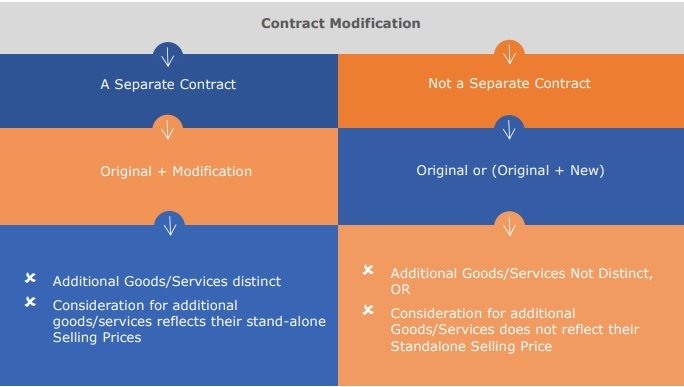
A contract modification exists when there is a change in the scope and/or the price of a contract. Upon approval of a change in an existing contract, it is accounted for as a separate contract, termination of the existing contract and creation of a new contract, or as part of the existing contract.
Separate contract:
A contract modification is accounted for as a separate contract (prospective treatment) when both of the following criteria are met:
- The additional goods and services are distinct from the goods and services in the original arrangement; and,
- The amount of consideration expected for the added goods and services reflects the standalone selling price of those goods and services.
Existing contract / New Contract:
- A contract modification that does not meet the above criteria is considered a change to the original contract and is accounted for as either the termination of the original contract and the creation of a new contract, or as a continuation of the original contract, depending on whether the remaining goods or services to be provided after the contract modification are distinct from the goods or services transferred to the customer on or before the date of the modification.
- A modification is accounted for on a prospective basis, or said differently, a termination of the existing contract and creation of a new contract, if the goods and services subject to the modification are distinct from the other goods and services provided within the original contract but the consideration does not reflect the standalone selling price of those goods or services.
- A modification is accounted for as a continuation of the original contract if the goods or services added or removed are not distinct from the goods and services already provided; such modifications are accounted for on a cumulative catch-up basis. This scenario is considered to be rare.
Once a contract modification has been determined to be either a separate contract, a termination of the existing contract and creation of a new contract, or as part of an existing contract, the Company will recognize revenue for the contract consistent with the above policies.
Flow Chart for a better understanding:
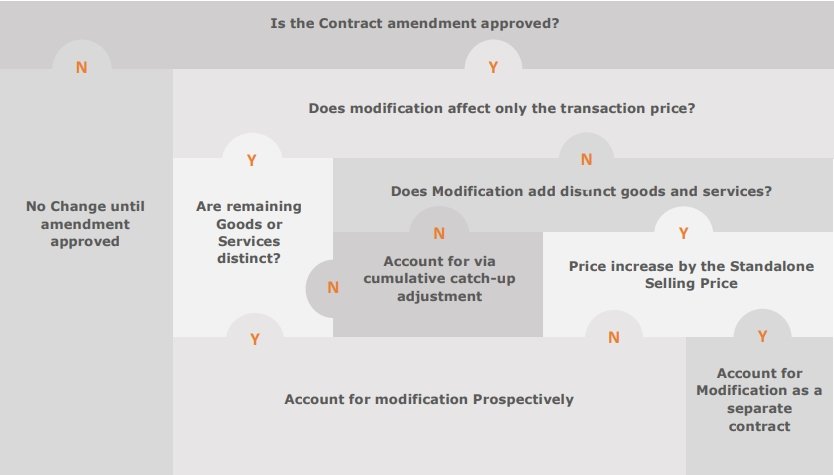
IDENTIFY THE PERFORMANCE OBLIGATIONS IN THE CONTRACT
Step 2 – This Step requires the Company to identify performance obligations and whether the promises to transfer either goods or services are distinct performance obligations. This section discusses the requirements and provides conclusions for our general performance obligations in our contracts with customers. Each contract will need to go through this evaluation.
ASC 606-10-25-14 states that at contract inception an entity shall assess the goods or services promised in a contract with a customer and shall identify, as a performance obligation:
A performance obligation is a promise to transfer goods and/or services to a customer. The hospital needs to consider the common business practices and identify all the goods and services within the contract to determine which of those need to be grouped together in a single performance obligation and others to be recognized as a separate performance obligation.
This is a crucial step in applying the 5-step model because revenue allocated to each performance obligation is recognized when the obligation is satisfied.
Healthcare Entities often sell products and services that are bundled together and these bundles are generally distinct in terms of identification for contract terms, prices and performance obligation. These bundles may be provided to the customer on free, promotional or discounted rates so as to entice customers to enter into contracts.
A good or service is distinct if both of the following criteria are met:
a. Capable of being distinct ñ the customer can benefit from the good or service either on its own or together with other resources that are readily available to the customer
b. Distinct within the context of the contract ñ the promise to transfer the good or service is separately identifiable from other promises in the contract
In assessing whether an entityís promises to transfer goods or services to the customer are separately identifiable, the objective is to determine whether the nature of the promise, within the context of the contract, is to transfer each of those goods or services individually or, instead, to transfer a combined item or items to which the promised goods or services are inputs.
A series of distinct goods or services that are substantially the same are accounted for as a single performance obligation if:
- Each would be a performance obligation satisfied over time; and
- The same method would be used to measure the companyís progress toward satisfaction
Material Rights
ASC 606-55-42 states, ìif, in a contract, an entity grants a customer the option to acquire additional goods or services, that option gives rise to a performance obligation in the contract only if the option provides a material right to the customer that it would not receive without entering into that contact (for example, a discount that is incremental to the range of discounts typically given for those goods or services to that class of customers in that geographical area or market).î If a material right gives rise to a performance obligation, then when we reach Step an allocation of the transaction price to this performance obligation is required.
If the customer is provided a right to buy additional goods and services at a price which is in range of prices charged for those goods and services i.e. Standalone selling prices, then such option does not give any material right.
The Companyís revenue transactions may include a combination of the following (Not exhaustive list):
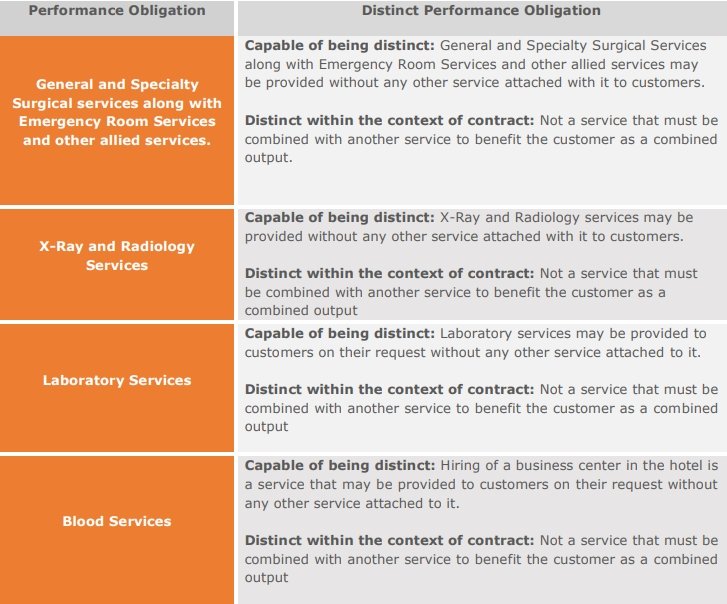
Series of distinct goods or services
The Companyís contracts contain promises to deliver a distinct series of services that are substantially the same. If the distinct series of services meet both of the criteria below, they are considered to be a single performance obligation:
- Each distinct service in the series that the Company have promised to transfer to the Companyís customer would meet the criteria of a performance obligation satisfied over time
- The same method would be used to measure the Companyís progress toward complete satisfaction of the performance obligation to transfer each distinct service in the series to the Companyís customer
DETERMINE THE TRANSACTION PRICE
Step 3 – This Step of the revenue recognition model requires the Company to determine the transaction price for the contract. This section discusses the potential transaction price components and how they may increase or decrease the overall transaction price. Each contract will need to go through this evaluation.
The Company considers the terms of the contract and its customary business practices to determine the transaction price. The transaction price is the amount of consideration to which the Company expects to be entitled in exchange for transferring goods or services to a customer, excluding amounts collected on behalf of third parties such as sales taxes. The following items are taken into consideration when determining transaction price and are discussed in further detail throughout this section.
+ Fixed Consideration (includes consideration related to performance obligations and activation fees)
+ Estimated Variable Consideration
– Contingent Amounts (unless no revenue reversal is probable)
– Consideration Payable to the Customer
+ Noncash Consideration
± Significant Financing Component
– Amounts Collected on Behalf of Third Parties
= Transaction Price
When determining the transaction price, the Company assumes that the goods or services will be transferred to the customer based on the terms of the existing non-cancellable contract and does not take into consideration the possibility of the contract being canceled, renewed, or modified. The Company also considers the effects of the following:
1. Variable consideration (and the constraint)
Forfeitures, refunds, rights of return, price concessions, payments contingent on future events, and similar items give rise to variable consideration which, in turn, affects the transaction price for an arrangement. The Company will determine how much variable consideration can be included in the overall transaction price at contract inception. This determination is comprised of the following two steps:
a. Estimate the amount of variable consideration;
b. Determine whether any of the estimated amounts are subject to a probable revenue reversal (this concept is referred to as ìthe constraintî in the literature).
ASC 606-10-32-8 suggests two alternatives to use (be consistently applied throughout the life of the contract) when estimating the amount of variable consideration:
a. The expected value method:
Sum of probability-weighted amounts in a range of possible consideration amounts
b. The most likely amount method:
The single most likely amount in a range of possible consideration amounts
Variable consideration may include amounts that could be refunded, returned, or uncollected from customers or resellers, rebates in the form of cash or credits provided to resellers for meeting certain sales targets, booking targets, etc., credits to end-users, price concessions, incentives, performance bonuses, penalties, usage-based fee, price protection, time and materials contracts, usage overages on subscription contracts, or other similar items.
In the case of a Hospital, variable consideration would be the amount that remains uncollected from a self-pay patients (i.e. uninsured patients).
2. Concessions
The Company may provide infrequent concessions to certain customers in order to keep customer loyalty to the Company intact. These concessions typically result in free or reduced-price maintenance and support services /extension of payment term
Under ASC 606, concessions are generally viewed as any post-execution change to the original agreement between the Company and the customer that increases the customerís rights or the Companyís obligations. Concessions may impact the determination of performance obligations and/or transaction price and could be considered a contract modification. As such, concessions should be considered throughout the five-step revenue recognition framework. Discussion of concessions is placed in the transaction price section of the policy as transaction price is frequently impacted by concessions.
Concessions may take many forms and include, but are not limited, to the following:
– Accepting returns that are not required under the terms of the original arrangement;
– Reducing the arrangement fee or extending the terms of payment; or
– Increasing the deliverables or extending the customerís rights beyond those in the original transaction, without an appropriate increase in fees
The Hospital will assess whether to include estimated concessions in the transaction price on a contract-by-contract basis when and if concessions are expected to be provided. As of the date of this policy, the Hospital does not have a history of granting concessions and, as such, estimated concessions will not be included in the transaction price.
3. The Consideration payable to a customer
The Company evaluates consideration payable to a customer to determine whether the amount represents a reduction of the transaction price, payment for distinct goods or service, or a combination of the two. Consideration payable that does not exceed the fair value of distinct goods or services shall be accounted for as a purchase from suppliers. The consideration payable that exceeds the fair value of distinct goods or services shall be accounted for as a reduction to the transaction price with the remainder accounted for as a purchase from suppliers. If the Company cannot reasonably estimate the fair value of goods or services received from the customer, then it will account for all consideration payable to the customer as a reduction of the transaction price at the later of when the Company recognizes revenue for the transfer of the related goods or services and the Company pays or promises to pay the consideration.
4. Sales taxes
The Company excludes all taxes assessed by governmental authorities from the measurement of the transaction price as allowed by ASC 606-10-32-2A as the taxes collected by the Company are levied against its customers. The Company is considered an agent for the governmental authority and therefore the taxes collected are not included in the transaction price.
ALLOCATE THE TRANSACTION PRICE TO THE PERFORMANCE OBLIGATIONS IN THE CONTRACT
Step 4 – This Step of the revenue recognition model requires the Company to allocate the transaction price to the performance obligations in the contract. This section discusses how standalone selling prices are determined and how the transaction price will be allocated using the standalone selling prices or other appropriate methods. Each contract will need to go through this evaluation.
Allocating the transaction price to performance obligations
The Company allocates a portion of the total transaction price to each performance obligation based on the relative stand-alone selling price (SSP) of each performance obligation. The amount allocated, therefore, represents the amount of consideration to which the Company expects to be entitled in exchange for providing the goods or services included in the performance obligation. SSP is determined at the inception of the contract for each performance obligation.
Once the Company has determined the transaction price, a portion of the total transaction price is allocated to each performance obligation in a manner depicting the amount of consideration to which the Company expects to be entitled in exchange for transferring the goods or services to the customer (the ìallocation objectiveî). The first step is to determine the SSP of each performance obligation. Once the SSPs have been determined, the second step is to allocate the transaction price based on the performance obligationsí relative SSPs.
However, in some cases, a discount or variable consideration may be allocated to one or more, but not all, performance obligations in the contract. See the discussion of these cases in sections. Allocating variable consideration, and Discount Allocation, below SSP, is determined at the inception of the contract for each performance obligation. After contract inception, no reallocation of the transaction price is made to reflect subsequent changes in SSPs.
Determining standalone selling prices
The following shows the Companyís decision-making process for selecting a standalone selling price:
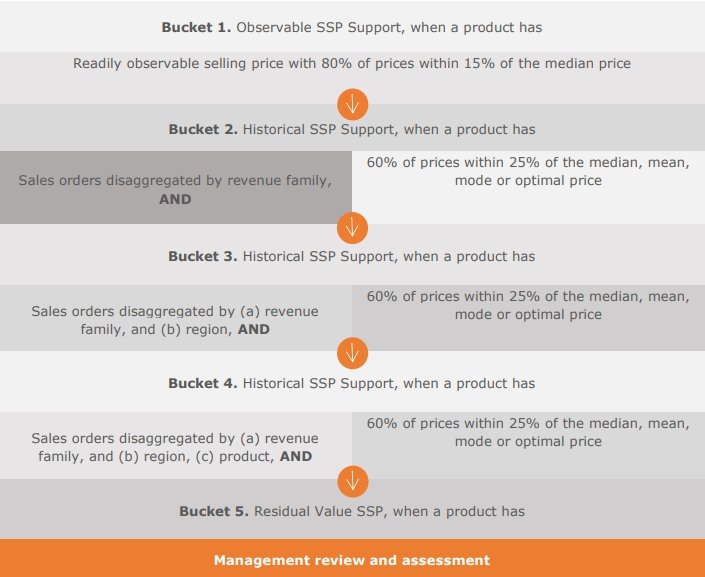
SSP is the price at which the Company would sell a promised good or service separately to a customer. The best evidence of SSP is an observable SSP, which is the ìprice of a good or service when the entity sells that good or service separately in similar circumstances to and to similar customersî per ASC 606-10-32-3.
The Company considers SSP to be a range of prices. The Company will apply judgment in determining what constitutes an appropriate SSP range. Any such range will be established based on an analysis that maximizes observable inputs and supports an assertion that any price within that range would be a valid pricing point if the performance obligation were sold on a stand-alone basis.
Determining observable SSP
The Company first concludes whether an observable SSP exists. An observable SSP is the price of a good or service when the entity sells that good or service separately in similar circumstances and to similar customers. The Company conducts a regular analysis to determine whether various services have an observable SSP. If an observable SSP exists, it is used for allocation purposes. If there is a relatively narrow range of observable prices, then a stated contract price within that range is an acceptable SSP. The Company considers observable SSP to exist when
a. 80% of contract prices for a separately sold service to be within 15% of an estimated SSP, and
b. there are a sufficient number of observed contracts to reasonably estimate SSP.
Determining SSP based on historical prices
If the Company does not have an observable SSP then, the Company next assesses whether products have an estimated SSP by considering its historical pricing. Historical prices include both
a. observed in transactions within the last twelve months and
b. standalone and non-standalone transactions.
The Company considers historical SSP to exist when
a. 60% of contract prices for a separately sold service to be within 25% of an estimated SSP, and
b. there are a sufficient number of observed contracts to reasonably estimate SSP.
Determining SSP for low-coverage products
If the historical standalone selling price is not available after disaggregating the product revenue family, Management reviews the specific item and makes its best estimate of SSP. This analysis may consider the following:
a. Adjusted market assessment
Prices based on SSP of similar goods or services or SSP observed in another market and adjusted for known differences in functionality, markets, etc.
b. Expected cost plus a margin
Prices based on a forecast of the expected costs plus an appropriate margin for the service.
c. Combined method
Prices established for a bundled (combined) performance obligation based on combining SSP of individual goods or services included in the bundle, and adjusting for the effect of bundling, as appropriate. The Company does not believe it will utilize this method.
The following table outlines the Companyís distinct performance obligations and the method that is most frequently used to establish SSP:
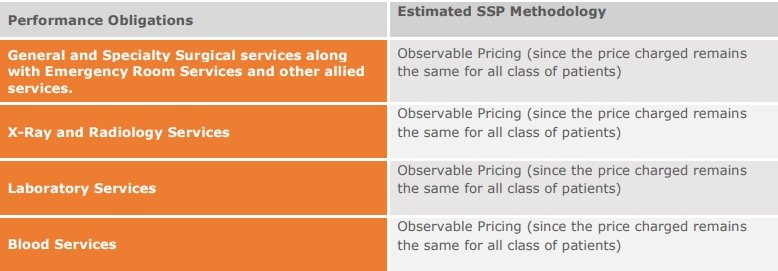
Frequency of updating the SSP analysis
The Hospital estimates SSP on an annual basis, or as needed when standard discounts are updated or new products are introduced in the market. On a quarterly basis, the Hospital will revise its estimate of SSP if there is a material change in the SSP.
Allocating variable consideration
Variable consideration may be attributable to:
i. All of the performance obligations in a contractóincluding amounts that could be refunded, returned, or uncollected from customers or resellers, rebates in the form of cash or credits provided to resellers for meeting certain sales targets, booking targets, etc., credits to end-users, price concessions, incentives, performance bonuses, penalties, price protection, or other similar items;
ii. One or more, but not all, of the performance obligations in a contractóincluding time and materials contracts, and usage-based fees; and
iii. One or more, but not all, of the distinct goods or services, promised in a series of distinct goods or services that forms part of a single performance obligationóincluding usage overages on subscription contracts.
The Company will allocate variable amounts, along with subsequent changes to such amounts, entirely to one or more, but not all performance obligations when both of the following criteria are met:
i. The variable payment terms relate specifically to the entityís efforts to satisfy the performance obligation; and
ii. Allocating the variable amount of consideration entirely to the performance obligation is consistent with the allocation objective when considering all of the performance obligations and payment terms in the contract.
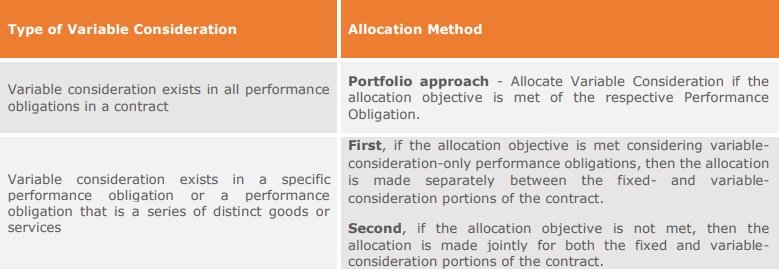
Portfolio approach ñ The new standard is applied to an individual contract with the customer. However, as a practical expedient, an entity may apply the revenue model to a host of contracts clubbing them together as a portfolio. A portfolio of contacts will consist of those contracts which exhibit similar characteristics and the entity reasonably expects that the effect of applying this approach as opposed to applying the 5-step model to the individual contract would not result in a material difference to the financial statements.
Allocation objective ñ At the commencement of the contract, the transaction price is generally allocated to each performance obligation on the basis of relative standalone selling prices. However, when specified criteria are met, a discount or variable consideration is allocated to one or more performance obligations in the contract. This is known as allocation objective.
RECOGNIZE REVENUE WHEN (OR AS) THE ENTITY SATISFIES A PERFORMANCE OBLIGATION
Step 5 – This Step of the revenue recognition model requires the Company to recognize revenue when (or as) it satisfies a performance obligation, which is determined by the transfer of control to the customer. This section discusses potential impacts to the timing of the transfer of control, the types of transfer of control and the likely recognition method for the Companyís various performance obligations. Each contract will need to go through this evaluation.
The Company recognizes revenue when (or as) it satisfies a performance obligation by transferring promised goods or services to its customers. The good or service is considered transferred when the customer gains control of the good or service. Control of an asset refers to the ability to direct the use of and obtain substantially all of the remaining benefits from the asset. Control also means the ability to prevent other entities from directing the use of and receiving the benefit from, a good or service.† If control transfers over time, revenue will be recognized over time in a manner depicting The Companyís performance in transferring control of the good or service. If control transfers at a point in time, revenue will be recognized at that point.
Per ASC 606-10-25-27, transfer of control occurs over time if one of the following criteria is met:
a. The customer simultaneously receives and consumes the benefits provided by the entityís performance as the entity performs
b. The entityís performance creates or enhances an asset that the customer controls as the asset is created or enhanced
c. The entityís performance does not create an asset with an alternative use to the entity (e.g., the ability to sell the asset to a different customer), and the Company has an enforceable right to a proportionate amount of payment if the customer were to terminate the contract. Generally, our professional services meet this condition as
i. the nature of our professional services are generally customized to our customerís specific requests and needs, and
ii. these services are not transferable to other customers (i.e., they provide value to the Company.
The customer receives and consumes the benefits as the entity performs if another entity would not need to substantially re-perform the work completed to date to satisfy the remaining obligations. The fact that another entity would not have to re-perform work already performed indicates that the customer receives and consumes the benefits throughout the arrangement.
If a performance obligation is not satisfied over time it is satisfied at a point-in-time. Per ASC 606-10-25-30, indicators of transfer of control that would likely result in point-in-time revenue recognition include:
a) The Company has a present right to payment for the asset
b) The customer has legal title to the asset
c) The Company has transferred physical possession of the asset
d) The customer has the significant risks and rewards of ownership of the asset
e) The customer has accepted the asset.
The following table summarizes how the Company transfers control for each performance obligation based on the above guidelines.
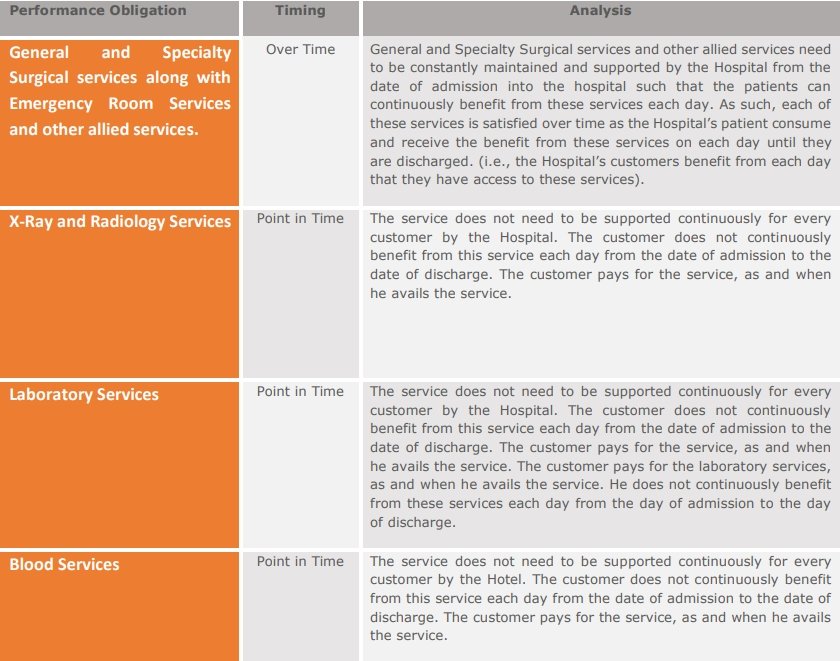
Once the determination of how control is transferred, the method for measuring the progress of satisfying a performance obligation must be selected. For performance obligations satisfied over time, a company may select either an output method or input method as provided under ASC 606.
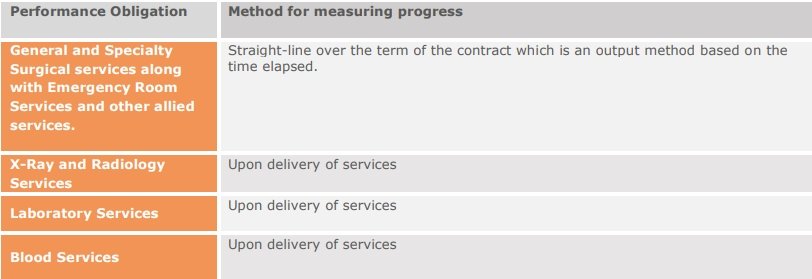
Contract Costs
ASC 340-40 specifies the accounting for costs an entity incurs to obtain and fulfill a contract to provide goods and services to customers. The incremental costs of obtaining a contract (i.e., costs that would not have been incurred if the contract had not been obtained) are recognized as an asset if the entity expects to recover them. The standard provides a practical expedient that permits an entity to immediately expense contract acquisition costs when the asset that would have resulted from capitalizing these costs would have been amortized in one year or less.
An entity accounts for costs incurred to fulfill a contract with a customer that is within the scope of other authoritative guidance (e.g., inventory, property, plant and equipment, internal-use software) in accordance with that guidance. If the costs are not in the scope of other accounting guidance, an entity recognizes an asset from the costs incurred to fulfill a contract only if those costs meet all of the following criteria:
- The costs relate directly to a contract or to an anticipated contract that the entity can specifically identify.
- The costs generate or enhance resources of the entity that will be used in satisfying (or in continuing to satisfy) performance obligations in the future.
- The costs are expected to be recovered.
Any capitalized contract costs are amortized, with the expense recognized as an entity transfers the related goods or services to the customer. Any asset recorded by the entity is subject to an impairment assessment at the end of each reporting period.
PRESENTATION ON THE STATEMENT OF FINANCIAL POSITION
Presentation
- Hospital entities record contract assets and contract liabilities depending on their business practices. The standard requires that an entity present contract assets and liabilities in the statement of financial position.
- Contract assets and liabilities should be presented at the contract level and not at the line level i.e. at the performance obligation level. Thus, the entity should aggregate contract assets and liabilities within a contract into one single contract liability and asset and not recognize it separately for each performance obligation or line level.
- Standard does not require the entity to comply with usage of terms contract assets and contract liability, however, presentation of the financial information should be in such manner that the users of financial statements can clearly distinguish between unconditional right to consideration (e.g. receivables) and conditional right to receive consideration (e.g. contract assets, unbilled receivables).
- Hospital entities need to provide information regarding contracts that would generate contract assets (e.g. service agreements with lock-in period) and contract liabilities (prepayments from patients).
Disclosures
- Hospital entities are required to provide a comprehensive set of disclosures about revenue from a contract with customers in the financial statements. The disclosures also apply to interim financial statements.
- For public entities, the disclosures include qualitative and quantitative information about contracts with customers, revenue disaggregationís, significant judgments and policies decided by the entity for consistent application of the standard, costs capitalized while obtaining the contract and costs incurred for the fulfillment of the contract. Non-public entities can voluntarily opt for the same level of disclosures as the public ones or decide for a reduced level of disclosures.
- Disaggregated revenue disclosure should depict categories of revenue in such a way that the nature, amount, timing of revenue and cash flows are distinct for different streams. While disaggregating the revenue, hospital entities should consider how it will affect the presentation of information in financial statements as well as from an investor point of view. Revenue may be disaggregated on the basis of service plans, types of customers, types of contracts and geographical locations.
- The Entity does not require to duplicate the disclosure required by other standards. For example ñ an entity that is providing revenue disaggregation disclosure as per segment reporting is not required to give the same disclosure as per this standard.
- Qualitative and quantitative disclosures include information about performance obligations, contract assets, and contract liabilities, capitalized costs incurred for obtaining the contract, costs incurred for fulfilling the contract.
- Disclosures should also be made about significant judgments made for applying the standard along with changes made to existing policies which will result in changes to the amount and timing of revenue recognition. Entities will need to disclose Judgements and changes in judgments made for determining the transaction price, performance obligations and its satisfaction, allocation of the transaction price to performance obligation, estimating the standalone selling price, variable consideration, determining whether some rights give rise to material rights and their accounting, allocation of discounts to contracts.
- The disclosure requirements also apply to interim financial statements.
CASE STUDY
Based on the above considerations and in reference to various requirements of the guidance, a typical transaction can be molded as below:
Let us assume that a Patient ìPatient Aî visits a hospital for Coronary Artery Bypass Surgery (CABS) which includes hospitalization for 5 days which includes Emergency Room Services and other allied services.
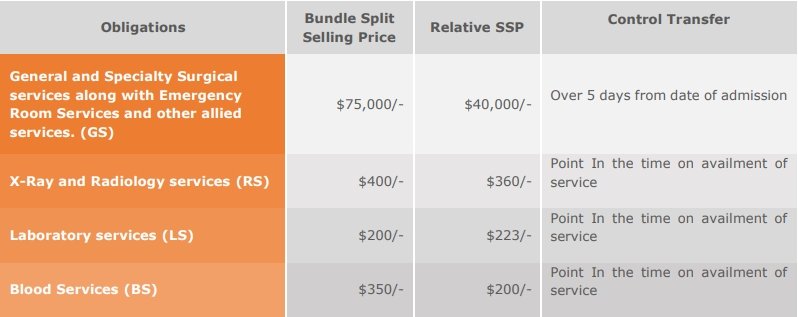
Step 1: Identify the contract with the customer
The contract is mutually agreed upon between the patient and the hospital. Terms of payment are defined in the contract. Also, the payment is enforceable as well as collectible from the patient.
The Hospital combines two or more contracts entered into at or near the same time, same location and with the same patient and accounts for the combined contracts as a single arrangement. In this case, the contract entered with the patient for 5 days will be considered as a single contract with the patient.
Step 2: Identifications of Performance obligations (PO)
For General and Specialty Surgical services and allied services: Over Time recognition from the date of admission.
For X-Ray Services: Point in Time on availment of service.
For Laboratory Services: Point in Time on availment of service.
For Blood Services: Point in Time on availment of service.
(The reasons for choosing the method of recognition viz overtime or point in time have been mentioned above)
Step 3: Determine the transaction price
The hospital is a multispecialty hospital with specialization in heart surgeries.
It is assumed that the transaction price is based on cost plus profit. It also considers the goodwill attached to the name of the Hospital while charging its patients.
Transaction price as per contract is
For General and Specialty Surgical services and allied services: $75,000/-
For X-Ray Services: $400/-
For Laboratory Services: $150/-
For Blood Services: $350/-
Step 4: Allocation of Transaction Price
Based on Relative Standalone Selling price the allocation of Transaction price would be as below:
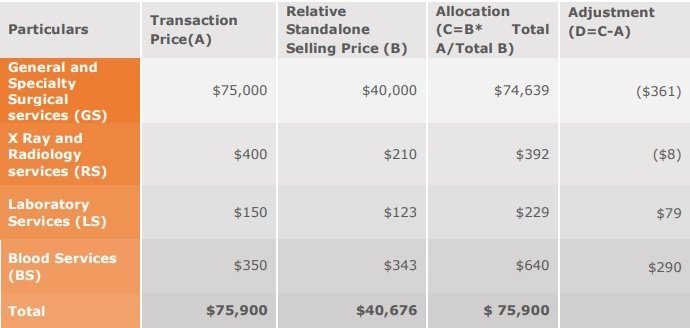
Relative Standalone Selling Price has been determined using the market rates of hospitals of a similar category.
Step 5: Recognition of Revenue
Recognition schedule over 5 days

Accounting Entries
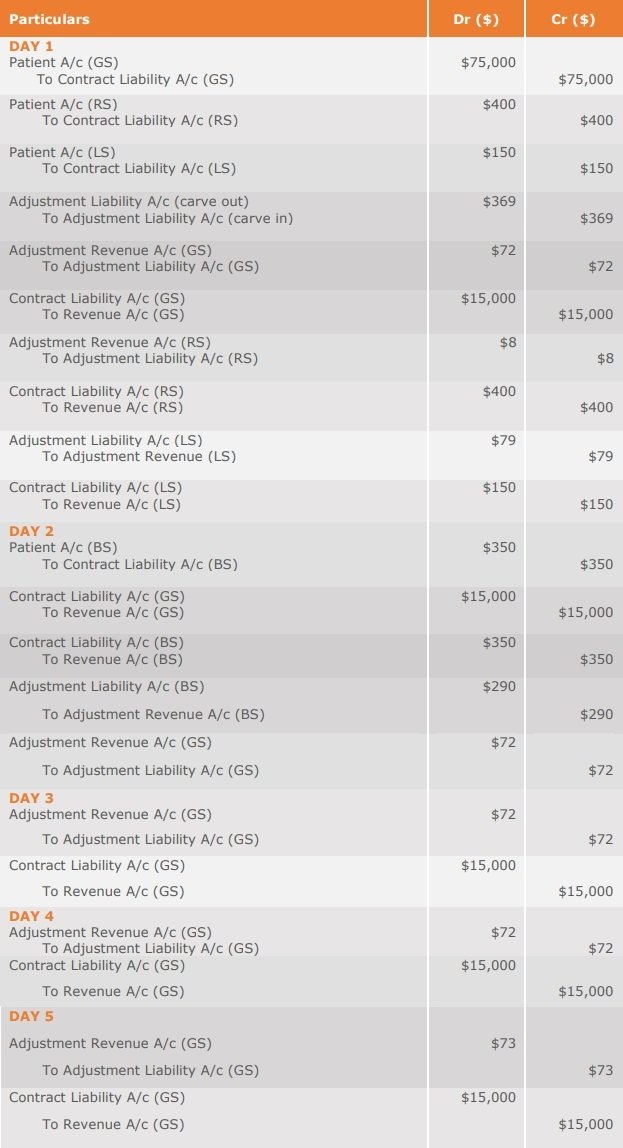
Disclosure Requirements
Notes:
Valuation hierarchy:
A three-level valuation hierarchy has been established under U.S. GAAP for disclosure of fair value measurements. The valuation hierarchy is based on the transparency of inputs to the valuation of an asset or liability as of the measurement date. The three levels are defined as follows.
- Level 1 – inputs to the valuation methodology are quoted prices (unadjusted) for identical assets or liabilities in active markets.
- Level 2 – inputs to the valuation methodology include quoted prices for similar assets and liabilities in active markets, and inputs that are observable for the asset or liability, either directly or indirectly, for substantially the full term of the financial instrument.
- Level 3 – one or more inputs to the valuation methodology are unobservable and significant to the fair value measurement. A financial instrumentís categorization within the valuation hierarchy is based on the lowest level of input that is significant to the fair value measurement.
Disaggregation of Revenue:
The Companyís revenue was comprised of the following major product and service lines (in thousands):
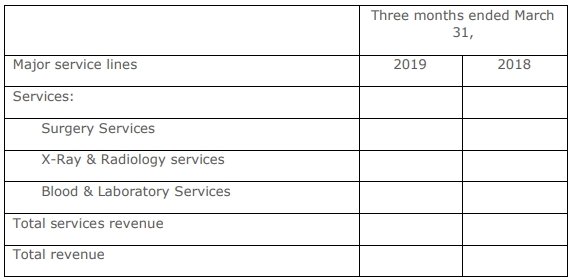
The Companyís revenue by geographic region, based on the customerís location, is summarized as follows (in thousands):
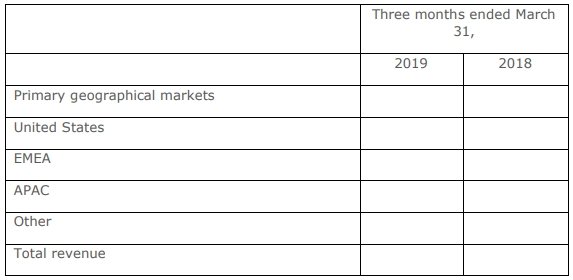
The following table presents the Companyís revenue by the timing of revenue recognition (in thousands):
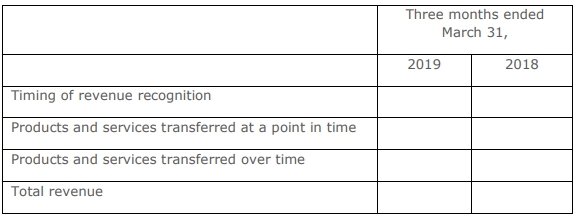
Contract Balances:
The following table provides information about receivables, unbilled revenues, and deferred revenues from contracts with customers (in millions). Unbilled revenues are presented as part of prepaid expenses and other current assets and other assets in the Companyís consolidated balance sheets:

Significant changes in the unbilled revenues and the deferred revenues balances during the period are as follows:
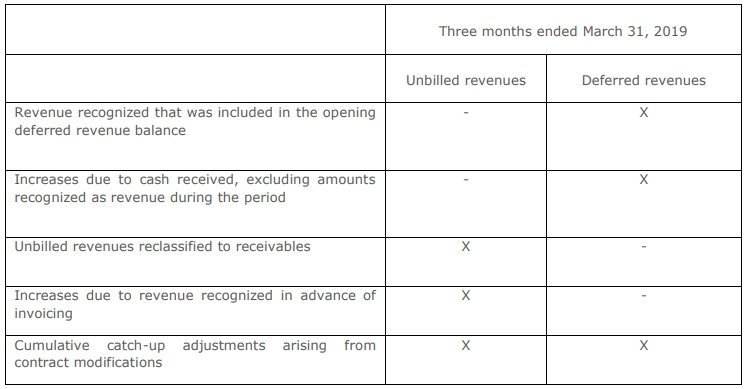
Transaction Price Allocated to the Remaining Performance Obligations:
The following table includes estimated revenue expected to be recognized in the future related to performance obligations that are unsatisfied (or partially unsatisfied) as of March 31, 2019 (in millions).

Contract costs:
Costs incurred to obtain the contract:

Costs incurred to fulfill the contract:
Did you find this case study on ASC 606 helpful?
We will be happy to answer any questions/queries regarding this and any other topics regarding Revenue Recognition and ASC 606.
